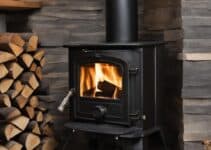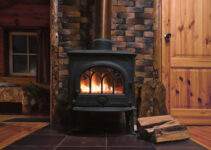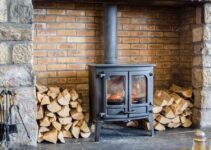When it comes to elevating the comfort and charm of one’s home, the choice of materials for a wood stove door plays a pivotal role. I understand that finding the perfect blend of a durable log burner door, energy-efficient features, and stylish aesthetic appeal can be quite the undertaking.
The material selected for wood stove doors must serve multiple purposes; it should withstand high temperatures, contribute to your stove’s efficiency, and also complement the room’s design. In this regard, let’s reveal the insights on the most suitable materials that will enhance the performance and look of your wood burner.
Understanding Your Wood Stove: Fireplace vs Wood Burner Efficiency
As a discerning homeowner looking to enhance the cosiness and warmth of my dwelling, grasping the intricacies of wood stove efficiency plays a pivotal role. The choice between a high-efficiency fireplace and a traditional wood burner is not merely one of personal preference, but also of understanding the heat generation and conservation capabilities intrinsic to each design.
The Distinct Features of Wood Stoves and Fireplace Inserts
My findings reveal that wood stoves are celebrated for their singular door, usually coupled with a fire-gasket to secure an airtight seal, thus maximising heat retention. In contrast, a fireplace might boast of an elegant facade, complete with multiple doors, but it’s the fireplace insert that captures my attention as a significant upgrade in heat efficiency. When meticulously fitted into an existing masonry fireplace, the insert transforms it into a veritable heat powerhouse, rivalling the standalone wood burner’s proficiency.
Maximising Heat with Efficient Wood Burning Appliances
Indeed, a standalone wood burner emerges as the formidable choice for areas devoid of a fireplace, its robust design and focused heat dissemination turn it into an affordable, yet high-efficiency furnace. However, understanding the nuances of both options leads me to an enlightened choice of an affordable log burner door that synergises with my home’s heating apparatus, ensuring an optimised balance of efficiency and cost.
Whilst the particulars of each wood stove or fireplace insert model could extend to volumes, my focus on wood stove efficiency drives a deeper analysis into the comparative efficacies of various heating systems, all the while maintaining an eye towards manoeuvring within reasonable budget constraints without sacrificing quality.
| Feature | Wood Stove | Fireplace Insert |
|---|---|---|
| Door Design | Single door with airtight fire-gasket | May vary, insert fits within existing fireplace door |
| Heat Efficiency | High, due to complete combustion | High when used as an insert, improves existing fireplace |
| Cost-Effectiveness | Varies; high-efficiency models available | Cost-effective upgrade for existing fireplaces |
| Best for | Homes without existing fireplace | Enhancing efficiency of current fireplace |
Selecting the Proper Glass for Wood Stove Doors
When choosing the correct glass type for a wood stove door, it’s essential to understand the distinction between Tempered glass and Ceramic Glass to ensure fire resistance and durability. Both have unique attributes that make them suitable for different heating applications.
Tempered Glass – Its Application and Limitations
Tempered glass is prized for its safety features and strength over traditional glass, as it is designed to crumble into granular chunks rather than jagged shards if broken. However, for those seeking a fire resistant log burner door, tempered glass exhibits limitations. Typically, this type of glass is suitable for use in areas that do not encounter intense heat, as it can only endure temperatures of approximately 400-500 degrees Celsius before the risk of shattering increases significantly.
Ceramic Glass Varieties: Pyroceram and NeoCeram
For higher temperature applications, I recommend turning to the robust options within the Ceramic Glass category, such as Pyroceram and NeoCeram. Pyroceram, a form of Ceramic Glass, can withstand up to 1256 degrees Celsius, making it a commendable choice for wood burners with moderate heat output. For even more demanding conditions, NeoCeram offers an impressive capacity to withstand temperatures up to 1470 degrees Celsius. Its heightened resistance to thermal shock makes it an exceptional candidate for fire resistant log burner doors.
| Criteria | Tempered Glass | Pyroceram | NeoCeram |
|---|---|---|---|
| Heat Resistance | Up to 500°C | Up to 1256°C | Up to 1470°C |
| Application | Non-heat producing fireplaces | Wood, pellet, coal stoves | High heat wood, pellet, coal stoves |
| Shatter Behaviour | Crumbles into small pieces | Resistant to shattering | Resistant to shattering |
| Thickness | Variable | Less than NeoCeram | Thicker than Pyroceram |
In conclusion, when selecting glass for your wood stove door, it’s crucial to consider the temperatures your burner will reach. For those who require a fire resistant log burner door, NeoCeram offers the highest degree of thermal resilience, closely followed by Pyroceram, whereas tempered glass should be reserved for less intense heating environments.
Durability and Heat Resistance: Key Factors for Material Choice
When it comes to selecting a long-lasting log burner door, durability and heat resistance are paramount. In my experience, not all materials are created equal, and discerning homeowners are often on the lookout for a top quality log burner door that effortlessly withstands the rigours of intense heat.
While historical choices such as mica glass catered well to earlier generations of stoves, modern technology calls for materials like Pyroceram and NeoCeram. It’s these materials that provide the extreme heat resistance and high durability demanded by current wood stove models.
| Material | Heat Resistance | Visibility | Durability |
|---|---|---|---|
| Mica Glass | Up to 1800 degrees | Semi-transparent | Good for historical stoves |
| Pyroceram | Up to 1256 degrees | Transparent | High resistance to thermal shock |
| NeoCeram | Up to 1470 degrees | Transparent | Optimal for extreme temperature variations |
As a professional in this field, my advice leans towards Pyroceram and NeoCeram for their inherent qualities that align with safety, functionality, and aesthetic charm, ensuring your investment remains a center-piece of comfort in your home.
Best Materials Log Burner Door: A Comprehensive Comparison
When selecting the best materials log burner door, it’s imperative to consider how they stand up to the demanding conditions inherent in wood burning. Through my professional experience and technical knowledge, I believe it to be fundamental to conduct a detailed evaluation of the properties and resilience of ceramic glass and tempered glass, as these are the materials most frequently chosen by consumers.
Ceramic glass, such as Pyroceram and NeoCeram, is widely acknowledged for its thermal stability and resistance to moderate impact. Being able to withstand fluctuations in intense temperatures, these materials do not fail even when in direct contact with flames. This is why ceramic glass is often the highly recommended log burner door option and a staple material for those who prioritise long-term performance and safety.
Conversely, tempered glass, favoured for its strength when compared to standard plate glass, is regrettably less dependable under high temperatures. This susceptibility means that, while it can be a cost-effective short-term solution, it’s not suitable for use in high heat environments, and therefore, not usually considered the best material for a log burner door in practical scenarios.
| Material | Heat Resistance | Impact Resistance | Recommended Use |
|---|---|---|---|
| Ceramic Glass (Pyroceram/NeoCeram) | Up to 1200°C (Pyroceram), 1400°C (NeoCeram) | High | Wood Burners & High-Efficiency Stoves |
| Tempered Glass | Up to 500°C | Moderate | Decorative Gas Units, Low Heat Applications |
From my analysis, the decision seems clear. When considering a ceramic glass vs tempered glass comparison for a log burner door, ceramic glass typically offers superior durability and safety features necessary for the intense environment of a wood burner. This analysis aligns with industry standards and echoes the consensus amongst home heating professionals.
Installation and Maintenance: Tips for Longevity
The durability and efficiency of a log burner are profoundly influenced by the initial installation and the subsequent care it receives. My experience in do-it-yourself projects has reinforced my belief in the empowerment that comes with installing and maintaining your own wood stove door glass. Whether you’re tackling a new easy to install log burner door or engaging in log burner door maintenance, a few well-practised steps can ensure your wood stove continues to function at its best.
DIY Installation Guide for Wood Stove Door Glass
Replacing or installing wood stove door glass can be a manageable task, given that you have the right instructions and tools to hand. To help you achieve the wood stove door glass installation successfully, I’ll share a methodical approach:
- Firstly, check the manufacturer’s guide for specific instructions related to your wood stove model.
- Prepare the workspace by laying out your tools and protecting the area from any glass shards or debris.
- Remove the old glass carefully if replacing, and clean the frame of any residuals such as ash or gasket glue.
- Apply the new gasket adhesive according to the instructions and press the new gasket firmly in place around the edge of the clean glass.
- Carefully position the glass with the gasket attached into the door frame, secure it with the retaining clips or bolts, and avoid over-tightening.
With patience and precision, you’ll find the process to be less daunting than it appears. Remember, the goal is a secure and airtight fit to ensure maximum efficiency and safety from your wood burner.
Maintaining Your Log Burner Door for Sustained Performance
Maintaining the log burner door doesn’t have to be arduous if done regularly. An effective maintenance regime that I regularly follow includes:
- Regularly wiping down the glass with a soft cloth to remove soot and build-up.
- Checking the integrity of the door’s seals and gasket, replacing them if they show signs of wear or damage.
- Inspecting the glass for cracks and conducting timely replacements if any signs of damage arise.
Maintenance extends beyond cleaning; it includes vigilant observation for the lifespan of your burner. Spotting early signs of degradation can save you from more significant issues down the line. Product longevity and safety are, after all, paramount.
Conclusion
In my professional experience, the centrepiece of a cosy home is often a wood burner, where the warmth radiates not just from the flames, but from the seamless integration of both function and fashion. A durable log burner door is not just a utilitarian feature; it’s a statement of style—a stylish log burner that conveys a homeowner’s refined taste. Ceramic glass variants such as Pyroceram and NeoCeram are exemplary materials, offering peace of mind through their ability to withstand intense heat, thus significantly enhancing home warmth.
My research and practical insights affirm that a steadfast focus on selecting the proper material goes hand in hand with meticulous installation and prescribed maintenance. This triad is essential for the longevity of the wood stove’s serviceability. By making astute choices centred on the stove’s heat output and the frequency of use, one can consistently enjoy the dual benefits of an effective heating apparatus and an attractive interior feature.
Ultimately, the journey to a home that basks in the glow of an efficient and elegant wood burner begins with understanding the nuances of each material. My goal has been to elucidate these intricacies so that when you choose a door for your log burner, it is not just about selecting a barrier for the flames. It’s about choosing an enduring symbol of safety, efficiency, and warmth – a durable log burner door that complements your hearth, your home, and your lifestyle.
Source Links
- https://www.woodstove-fireplaceglass.com/blogs/learn-about-wood-stoves/what-kind-of-glass-should-i-use-in-a-wood-stove
- https://www.woodstove-fireplaceglass.com/blogs/learn-about-wood-stoves/what-type-of-glass-should-i-use-in-my-fireplace-or-wood-stove
- https://www.onedayglass.com/woodstove-glass/selecting-best-material-fireplace-woodstove/



